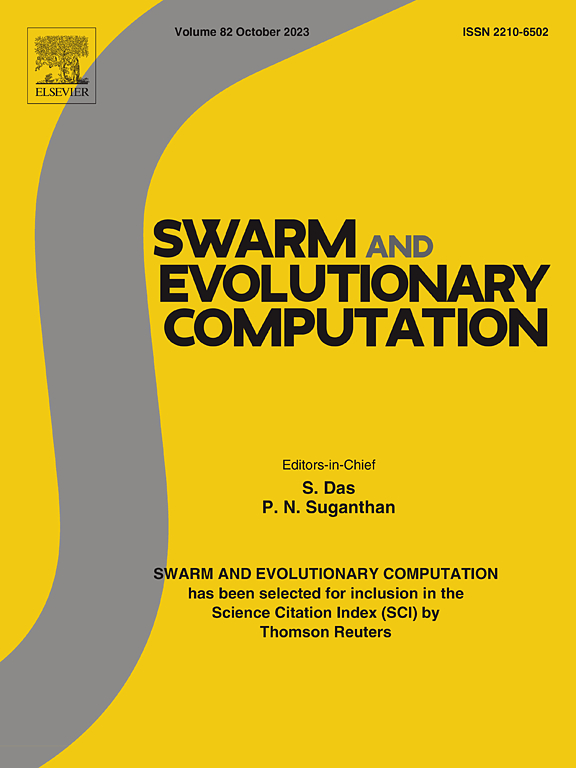A hybrid surrogate-assisted dual-population co-evolutionary algorithm for multi-area integrated scheduling in wafer fabs
IF 8.2
1区 计算机科学
Q1 COMPUTER SCIENCE, ARTIFICIAL INTELLIGENCE
引用次数: 0
Abstract
In wafer fabrication, multiple areas handle different processes and production flows. To maintain the desired chemical and physical properties of wafers, strict time window constraints (TWCs) must be observed as wafers progress through these areas. However, independent scheduling within each area without collaboration complicates resource allocation and hinders overall production optimization. Implementing multi-area integrated scheduling is thus essential for effective production management, aiming to reduce total lead time and production costs. This paper proposes a hybrid surrogate-assisted dual-population co-evolutionary algorithm (HSA-DPEA) to efficiently tackle the multi-area integrated scheduling problem under multiple TWCs. The algorithm employs a dual-population co-evolutionary mechanism, consisting of normal and auxiliary populations, to balance convergence and diversity while ensuring feasibility. The normal population focuses on feasible solutions to maintain overall quality, while the auxiliary population explores infeasible regions to identify promising individuals that can guide the normal population's evolution. To enhance evolutionary efficiency and reduce the number of time-consuming real fitness evaluations, a hybrid surrogate-assisted model is introduced. This model adapts by training regression or classification models at different stages of population evolution. Additionally, an online learning strategy based on convergence and diversity is employed for continuous model updating to improve accuracy. The proposed algorithm is tested on 18 instances and validated through six months of continuous testing on a wafer fab simulation system. The results demonstrate that HSA-DPEA obtains better Pareto optimal sets, effectively reducing total lead time and production costs in multi-area integrated scheduling under multiple TWCs.
晶圆厂多区域集成调度的混合代理辅助双种群协同进化算法
在晶圆制造中,多个区域处理不同的工艺和生产流程。为了保持晶圆片所需的化学和物理性能,晶圆片在通过这些区域时必须遵守严格的时间窗口限制(TWCs)。然而,在没有协作的情况下,每个区域内的独立调度使资源分配复杂化,并阻碍了整体生产优化。因此,实施多区域综合调度对于有效的生产管理至关重要,旨在减少总交货时间和生产成本。为了有效地解决多twc下的多区域综合调度问题,提出了一种混合代理辅助双种群协同进化算法(HSA-DPEA)。算法采用正常种群和辅助种群组成的双种群协同进化机制,在保证可行性的同时平衡收敛性和多样性。正常种群专注于可行的解决方案,以保持整体质量,而辅助种群探索不可行的区域,以识别有希望的个体,以指导正常种群的进化。为了提高进化效率,减少耗时的真实适应度评估,引入了一种混合代理辅助模型。该模型通过训练回归模型或分类模型来适应种群进化的不同阶段。此外,采用基于收敛和多样性的在线学习策略对模型进行持续更新,以提高准确性。该算法已在18个实例上进行了测试,并在晶圆厂仿真系统上进行了6个月的连续测试。结果表明,HSA-DPEA在多twc下的多区域集成调度中获得了更好的Pareto最优集,有效地降低了总交货时间和生产成本。
本文章由计算机程序翻译,如有差异,请以英文原文为准。
求助全文
约1分钟内获得全文
求助全文
来源期刊

Swarm and Evolutionary Computation
COMPUTER SCIENCE, ARTIFICIAL INTELLIGENCEC-COMPUTER SCIENCE, THEORY & METHODS
CiteScore
16.00
自引率
12.00%
发文量
169
期刊介绍:
Swarm and Evolutionary Computation is a pioneering peer-reviewed journal focused on the latest research and advancements in nature-inspired intelligent computation using swarm and evolutionary algorithms. It covers theoretical, experimental, and practical aspects of these paradigms and their hybrids, promoting interdisciplinary research. The journal prioritizes the publication of high-quality, original articles that push the boundaries of evolutionary computation and swarm intelligence. Additionally, it welcomes survey papers on current topics and novel applications. Topics of interest include but are not limited to: Genetic Algorithms, and Genetic Programming, Evolution Strategies, and Evolutionary Programming, Differential Evolution, Artificial Immune Systems, Particle Swarms, Ant Colony, Bacterial Foraging, Artificial Bees, Fireflies Algorithm, Harmony Search, Artificial Life, Digital Organisms, Estimation of Distribution Algorithms, Stochastic Diffusion Search, Quantum Computing, Nano Computing, Membrane Computing, Human-centric Computing, Hybridization of Algorithms, Memetic Computing, Autonomic Computing, Self-organizing systems, Combinatorial, Discrete, Binary, Constrained, Multi-objective, Multi-modal, Dynamic, and Large-scale Optimization.
 求助内容:
求助内容: 应助结果提醒方式:
应助结果提醒方式:


